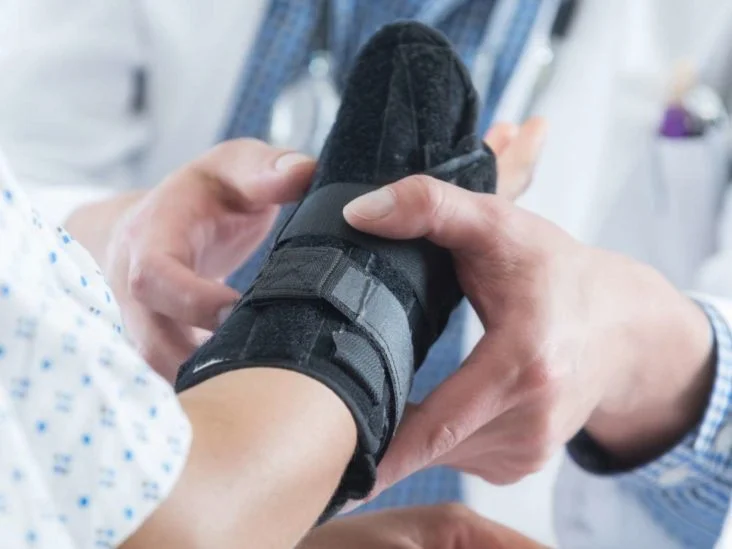Fractures are common during sports events, and you‘d do well to have some first-aid knowledge on supporting them. A fracture is a break that’s usually in a bone, resulting from severe trauma. If the broken bone appears through the skin, it’s called an ‘open fracture.’
If someone suffers from a fracture during a sporting activity, they may experience severe pain, deformity, swelling, blemishes on the skin, and immobility. Therefore, managing and supporting it as soon as possible is imperative.
Additionally, it’s essential to have a well-stocked first aid kit and have medical responders nearby to ascertain that enough care is provided to anyone who suffers from a fracture during a sports event.
Here are six tips for supporting a fracture:
1. Offer First Aid

The first step to take when you suspect a fracture should be offering first aid to manage the situation while you wait for medical help. It’s advisable to support the fractured part using a splint. You can check out sammedical.com to learn more about using splints, specifically sugar tong splints, to secure a fracture properly.
Another aspect you ought to consider when offering first aid is to elevate the limb and put on some ice to minimize swelling or bruising. You must clean and cover the wound with a sterile bandage if the skin is broken.
2. Applying Ice
Ice is crucial in reducing swelling, pain, and inflammation in a fractured area. A fracture can cause intense pain, and applying ice on the affected area can numb the area minimizing the pain. This is because ice decreases the activity of nerve endings around the fractured zone, thus reducing the pain sensation.
In addition, a fracture can give rise to swelling and inflammation around the affected region, making it difficult to move the limb. When ice is applied to the affected area, the blood vessels constrict, slowing the blood flow to the injured area and reducing swelling. The activity of immune cells is also reduced, thus minimizing inflammation.
Therefore, you can apply ice on the fractured area to make the injury manageable while promoting healing. Remember to exercise caution when applying ice to avoid damaging the skin or exacerbating the wound by using it for shorter periods.
3. Immobilize The Affected Area

Ensure that you minimize the mobility of the fractured area to prevent further damage. Any movement of a broken bone can damage the surrounding tissue, nerves, and blood vessels, making the situation worse.
Additionally, bones take time to heal, and immobilizing the affected area can secure the fractured bone in the correct position for proper healing. In such cases, immobilization and stabilization should be done delicately to allow recovery and prevent long-term damage.
In cases of severe and multiple fractures, you should call an emergency care provider to take care of the affected area to avoid causing more damage. Moreover, ensure the victim is comfortable with limited movements.
4. Seek Medical Help
Once first aid has been offered for a fracture, the next step would be to seek medical help. Seeking medical care is essential in diagnosing the fracture’s severity and suggesting appropriate treatment, such as bone repair.
If the fracture is severe with intense pain and difficulty with mobility, you can call for emergency services by dialing the emergency number in your country. When you get an emergency responder on the call, you’ll have to provide all the details on the injury and your location. It’s also crucial to provide information on the injured person’s current condition.
If the fracture doesn’t seem life-threatening, you can go to the nearest hospital or urgent care facility as soon as possible. If you’re the one who’s injured, it’ll help if you have someone accompanying you to assist with traveling and any support you might need.
5. Provide Emotional Support

When offering support to a fracture victim, it’s important to consider emotional care because it’s a painful and traumatic occurrence. There are several ways of showing support for someone that’s injured. You can provide emotional support by reassuring the victim that help is on the way while also helping them manage their pain and anxiety.
Additionally, it’s common for a fracture victim to feel anxious and worried about the injury and whether they’ll recover. For example, if an athlete suffers from a fracture during a sporting activity, they’ll be anxious about letting their team down or ever playing again. Therefore, emotional support and reassurance can help them feel at ease and focus on managing the injury.
Emotional care is also vital if the victim suffers from shock after the fracture. Shock is a severe condition that can occur if the body’s organs and tissues aren’t getting enough oxygen and nutrients because of decreased blood flow from the fracture.
You can know if a person is going through shock if they have any of the following symptoms:
- Confusion or disorientation
- Quick heartbeat
- Low blood pressure
- Shortness of breath
If you notice any of these symptoms of shock, ensure the person is comfortable and reassured while waiting for medical responders to arrive. You can also try to calm the victim by talking to them and engaging them in pain management.
6. Encourage Rest

Another essential aspect in supporting a fracture during a sporting event is encouraging the victim to rest and restrain from putting weight or strain on the affected limb until they receive medical care. Rest is essential because it ascertains that there’s no pressure placed on the affected area that can worsen the fracture.
Furthermore, resting can reduce the pain and discomfort from the fracture. This is because movement and pressure from any weight exerted on the fracture can slow the alignment and healing process, thus exacerbating the pain.
Resting also gives time to a medical intervention like immobilization, casting, and surgery where necessary. The medical intervention prescribed for a fracture depends on the severity and location.
Conclusion
Providing immediate and practical support is crucial if someone sustains a fracture during a sports event. The proper support is essential in reducing pain and discomfort as they seek medical care. With the guide in this post, you’ll be more equipped to provide support to someone suffering from a fracture.






